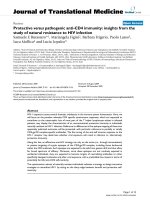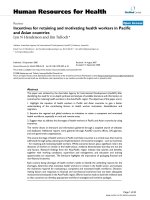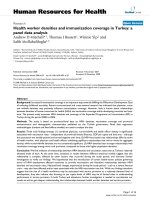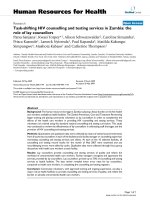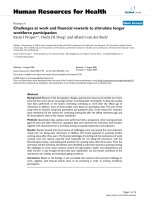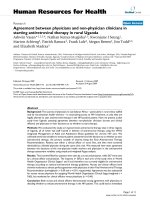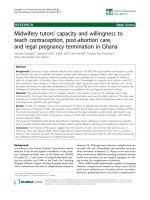báo cáo sinh học:" Task-shifting HIV counselling and testing services in Zambia: the role of lay counsellors" pot
Bạn đang xem bản rút gọn của tài liệu. Xem và tải ngay bản đầy đủ của tài liệu tại đây (215.03 KB, 7 trang )
BioMed Central
Page 1 of 7
(page number not for citation purposes)
Human Resources for Health
Open Access
Research
Task-shifting HIV counselling and testing services in Zambia: the
role of lay counsellors
Parsa Sanjana
1
, Kwasi Torpey*
1
, Alison Schwarzwalder
2
, Caroline Simumba
1
,
Prisca Kasonde
1
, Lameck Nyirenda
1
, Paul Kapanda
3
, Matilda Kakungu-
Simpungwe
4
, Mushota Kabaso
1
and Catherine Thompson
1
Address:
1
Family Health International/Zambia Prevention Care and Treatment Partnership, Lusaka, Zambia,
2
Columbia University Mailman
School of Public Health, New York, New York, USA,
3
Ministry of Health/DHMT, Mansa, Zambia and
4
Ministry of Health/DHMT, Ndola, Zambia
Email: Parsa Sanjana - ; Kwasi Torpey* - ; Alison Schwarzwalder - ;
Caroline Simumba - ; Prisca Kasonde - ; Lameck Nyirenda - ;
Paul Kapanda - ; Matilda Kakungu-Simpungwe - ;
Mushota Kabaso - ; Catherine Thompson -
* Corresponding author
Abstract
Background: The human resource shortage in Zambia is placing a heavy burden on the few health
care workers available at health facilities. The Zambia Prevention, Care and Treatment Partnership
began training and placing community volunteers as lay counsellors in order to complement the
efforts of the health care workers in providing HIV counselling and testing services. These
volunteers are trained using the standard national counselling and testing curriculum. This study
was conducted to review the effectiveness of lay counsellors in addressing staff shortages and the
provision of HIV counselling and testing services.
Methods: Quantitative and qualitative data were collected by means of semistructured interviews
from all active lay counsellors in each of the facilities and a facility manager or counselling supervisor
overseeing counseling and testing services and clients. At each of the 10 selected facilities, all
counselling and testing record books for the month of May 2007 were examined and any
recordkeeping errors were tallied by cadre. Qualitative data were collected through focus group
discussions with health care workers at each facility.
Results: Lay counsellors provide counselling and testing services of quality and relieve the
workload of overstretched health care workers. Facility managers recognize and appreciate the
services provided by lay counsellors. Lay counsellors provide up to 70% of counselling and testing
services at health facilities. The data review revealed lower error rates for lay counsellors,
compared to health care workers, in completing the counselling and testing registers.
Conclusion: Community volunteers, with approved training and ongoing supervision, can play a
major role at health facilities to provide counselling and testing services of quality, and relieve the
burden on already overstretched health care workers.
Published: 30 May 2009
Human Resources for Health 2009, 7:44 doi:10.1186/1478-4491-7-44
Received: 2 March 2009
Accepted: 30 May 2009
This article is available from: />© 2009 Sanjana et al; licensee BioMed Central Ltd.
This is an Open Access article distributed under the terms of the Creative Commons Attribution License ( />),
which permits unrestricted use, distribution, and reproduction in any medium, provided the original work is properly cited.
Human Resources for Health 2009, 7:44 />Page 2 of 7
(page number not for citation purposes)
Background
Zambia is among the countries hardest-hit by the HIV/
AIDS epidemic in Africa. It is estimated that 1.2 million of
the total Zambian population of 10 million was infected
with HIV by 2005 [1,2]. Although declining HIV trends
have been observed in young people since 1998, HIV/
AIDS in Zambia is still a major threat to the lives of adults
of reproductive age and their children [3]. Increasing
access to HIV counselling and testing – the entry point to
follow-on care, support and treatment services – could
alter this trend.
Shortages of health care workers (HCWs) have been a bot-
tleneck in the provision of HIV/AIDS services in resource-
limited settings. The World Health Organization/Ministry
of Health establishment recommends a staff population
ratio of 1:5000, 1:700, and 1:8000 for doctors, nurses and
pharmacists, respectively [4]. The existing human resource
capacity in Zambia is far below the recommended cadre-
to-population ratios, with existing levels of 1:17 589, 1:
8064 and 1:473 450 for doctors, nurses and pharmacists,
respectively [4].
With the rapid expansion of access to antiretroviral ther-
apy (ART), the increasing patient load will put a strain on
the existing fragile human resource base. Universal access
to ART treatment is inextricably linked to availability of
and access to HIV counselling and testing (CT) services.
However, the human resource shortage in Zambia, cou-
pled with a national HIV prevalence rate of 14.3% [1], is
placing a heavy burden on the few health care workers
available at health facilities to provide these services.
In May 2005, Family Health International's Zambia Pre-
vention, Care and Treatment Partnership (ZPCT), funded
by the United States Agency for International Develop-
ment (USAID) through the United States President's
Emergency Plan for AIDS Relief (PEPFAR), began training
and placing community volunteers as lay counsellors in
order to complement the efforts of the HCWs in providing
HIV counselling and help reduce their burden, using the
national HIV CT curricula.
This national training package includes a two-week class-
room component followed by a four-week supervised
practicum component. The lay counsellors are certified
after the practicum. The intensive training is able to
address individual learning needs related to education or
experience level.
The two-week classroom component of the training
includes instruction as well as role-plays and case studies
to ensure that trainees understand the concepts and meth-
ods of HIV counselling and testing. In the four-week
practicum, each trainee practices counselling and testing
under the supervision of an experienced CT provider. This
ensures that each trainee is able to practise and refine his
or her counselling skills. Each counsellor is certified only
after successfully completing both the classroom and the
practicum components of the training.
Lay counsellors were initially trained to provide only pre-
and post-test HIV counseling, because HIV testing could
be done only by HCWs. In May 2006, after certification of
an original cohort of lay counsellors, the Zambian
National HIV VCT guidelines were changed to allow non-
health care workers to conduct HIV testing by means of
finger-prick methodology. As a result, ZPCT began train-
ing all new and previously certified lay counsellors in HIV
testing in addition to counselling.
Lay counsellors are selected based on their ability to read
and write in English, residing within the facility catch-
ment area, and experience with the health facility for at
least one year. These criteria were used for both urban and
rural settings, but preference was given to those with some
level of background training in HIV/AIDS.
Prior to the introduction of lay counsellors, CT services
were provided primarily by nurses during their free time.
Existing human resource challenges and personnel short-
ages in many health facilities do not adequately address
the importance of accessible, good-quality CT services.
Most health facilities did not have staff dedicated to pro-
viding CT services – meaning that clients seeking the serv-
ice may not have a HCW available to provide the service.
By focusing specifically on the CT aspect of HIV services,
lay counsellors are able to devote more time to each client
than are HCWs. Certified lay counsellors are placed in
health facilities to provide services two to three days per
week. Although officially certified and integrated into the
operation of their facilities, lay counsellors are expected to
maintain their status as community-level volunteers. The
lay counsellor position is not part of the current MOH
establishment. Under the direction of an appointed facil-
ity manager, lay counsellors provide CT services on a part-
time basis under the supervision of facility managers.
ZPCT furnishes a stipend of 100 000 Zambian kwacha per
month (approximately USD 25) to cover travel expenses
for days worked at the facility.
The objective of this study was to assess the effectiveness
of lay counsellors in addressing human resource shortages
in the provision of HIV CT services in selected health facil-
ities. We also aimed to identify the extent and quality of
the services provided by lay counsellors in health facilities
and to assess differences in quality of services, client coun-
selling satisfaction and accuracy of data recording.
Human Resources for Health 2009, 7:44 />Page 3 of 7
(page number not for citation purposes)
Methods
The study was conducted in 10 health facilities in two
provinces in Zambia. A multi-stage purposive sampling
process of two of the five provinces in which ZPCT oper-
ates was selected. Luapula Province lies in the northern
section of the country and represents a rural population
base with an overall density of 15.3 people/km
2
[5]. The
second, Copperbelt Province, contains many of Zambia's
larger urban areas and represents a population base with
an overall density of 50.5 people/km
2
[5]. These two prov-
inces – one predominantly urban and one predominantly
rural – were selected in order to encompass variability in
HIV prevalence rates as well as potential differences in the
implementation and acceptability of lay counsellor CT
services.
Within these two provinces, all ZPCT-supported health
facilities in which lay counsellors had been trained, placed
and active for at least one year prior to study initiation
were selected for evaluation (a total of 10 health facili-
ties). Four of the selected health facilities were located in
Luapula Province, and six were located in Copperbelt
Province.
This final sample included facilities serving a range of
population catchment sizes and was composed of rural
health centres, urban clinics and secondary- and tertiary-
level government hospitals. Health facility staff selected
participating lay counsellors from among volunteers with
existing ties to the facility for at least one year. A list of the
facilities selected for the study appears in Table 1.
The study used both quantitative and qualitative meth-
ods. By means of semistructured interviews, data were col-
lected from all active ZPCT-trained lay counsellors in each
of the facilities, a facility manager or counselling supervi-
sor overseeing CT services and CT clients. All interviews
were conducted at the facilities during times convenient to
those interviewed; generally in-between clients or meet-
ings for counsellors or managers, and between or after
service appointments for clients. All those interviewed
were reminded that their responses would be kept confi-
dential and that the interpretation of their responses
would be unbiased.
CT recordkeeping was evaluated as a quality assurance
measure. At each of the 10 selected facilities, all CT record
books for the month of May 2007 (one month prior to
study initiation) were examined and any recordkeeping
errors were tallied. Standardized logs and instructions are
provided to each of the facilities to promote monitoring
and evaluation as well as to record the number of clients
seeking services and their basic demographics. The stand-
ardization of these logs allowed for the generation of a list
of mistakes to be considered recording errors. This list of
predetermined errors was then used to tally all those
found in each logbook used at these 10 facilities. A total
of 1083 entries was reviewed with a data accuracy check-
list. In addition, CT uptake data from October 2005 to
September 2006 and October 2006 to September 2007
before and after the introduction of lay counsellors were
reviewed to assess service statistics trends.
Qualitative data were collected through focus group dis-
cussions with health care workers at each facility.
Table 2 provides a summary of the type and number of
respondents and the data collection method used with
each group of respondents.
Data collected from semistructured interviews with lay
counsellors, clients and facility managers were analysed
both quantitatively and qualitatively. All quantitative data
analyses were performed with SAS statistical software, ver-
sion 9.1 (SAS Institute, Cary, North Carolina, United
States of America). All qualitative, open-ended question
responses were coded by hand to look for common
themes and then analysed to draw conclusions. Data gath-
ered from the quality assurance portion of the evaluation
were used to calculate error rates at the level of the facility
and of the province. Since these errors were also tallied
according to the initials of the recording CT provider, they
were also split by provider to assess differences between
lay counsellors and health care workers.
Results
Of the 19 lay counselors interviewed, six were based at
health facilities in Luapula and 13 at Copperbelt health
facilities. The average age of the lay counsellors was 44.8
years, ranging from 32 to 59 years. Eleven of the lay coun-
sellors interviewed were male (57.9%) and eight were
female (42.1%). More than half (57.9%) of lay counsel-
lors provided services at the health facility prior to train-
ing and placement as a lay counsellor. Fifteen lay
counsellors (78.9%) still assist with other services at their
assigned health facility, including community health edu-
cation and assisting with child health days.
Table 1: List of health facilities included in the study sample in
Luapula and Copperbelt provinces, Zambia
Luapula Province Copperbelt Province
Mansa General Hospital Ndola Central Hospital
Mansa Central Urban Clinic Chipokota Mayamba Clinic
Chembe Rural Health Centre Lubuto Health Centre
Senama Health Centre Mushili Clinic
Kawama Health Centre
Ndeke Clinic
Human Resources for Health 2009, 7:44 />Page 4 of 7
(page number not for citation purposes)
Job motivation
Lay counsellors were dedicated to their work and consider
themselves professionals. They were confident in their
counselling skills and found their work rewarding. When
asked about their main motivation for being a counsellor,
the most common response given was the ability to "help
people" and serve their community, as well as allusions to
how HIV/AIDS had touched them personally.
"Lots of people are dying without knowing their sta-
tus. We are role models and we can impart informa-
tion knowledge is power."
Services by lay counsellors
The data revealed that 70.5% of CT clients interviewed
received CT from a lay counsellor rather than a health care
worker at the study sites. With an average of 2.4 lay coun-
sellors at each facility visited (ranging from one to four),
lay counsellors were available almost all the time to pro-
vide CT services. The lay counsellors spent an average of
2.8 days (range 2 to 5) at their assigned health facility,
providing CT services to an average of 5.6 clients (range 3
to 8) per day.
Quality of services
The quality of counselling provided by lay counsellors
was high, and comparable to the CT services provided by
HCWs. Table 3 provides a comparison of results from cli-
ents served by a lay counsellor and a HCW, showing that
there is no difference across a number of factors assessed
(p-value > 0.05). In addition, data indicate that clients
who received CT services from a lay counsellor waited an
average of almost 15 minutes less than clients who
received CT services from a HCW.
Facility managers also rated the CT services provided by
lay counsellors as average to excellent. None rated the
services as below average.
Addressing the HCW workload and human resource issues
According to health facility managers interviewed, lay
counsellors have contributed significantly to reducing the
workload of HCWs, even having a "tremendous" or "over-
whelming" impact.
"They have given us a relief, coverage of CT services
has gone up and we have been able to reach our tar-
gets."
Table 2: Summary of respondents and sample size
Respondents Data Collection Sample Size Comments
Lay counsellors Semistructured interview 19 Maximum number available at each site (1–3 counsellors per site)
Health care workers Focus group discussion 16 Eight focus groups (one per health centre)
Health macility managers Semistructured interview 10 One per site
CT health facility clients Exit interview 95 Convenience sample of (5–11 clients per site)
Table 3: Comparison of counseling provided by lay counsellors and HCWs from client exit interviews (n = 95)
Question % of clients responding "yes" who were counseled by
Lay Counsellors HCWs p-value
Did staff/counsellor fully explain what to expect at the CT site? 98.5% 96.4% p > 0.05
Did the counsellor make you comfortable talking to him/her? 97.0% 100.0% p > 0.05
Did the counsellor display good skills in his/her counselling session? 98.5% 96.4% p > 0.05
Were you given the necessary information you need about HIV/AIDS? 94.0% 100.0% p > 0.05
Did the counsellor help you to identify ways of reducing your exposure
to HIV?
94.0% 100.0% p > 0.05
Overall, were the services you received at the CT centre satisfactory? 97.0% 100.0% p > 0.05
Human Resources for Health 2009, 7:44 />Page 5 of 7
(page number not for citation purposes)
All facility managers interviewed mentioned that the pres-
ence of lay counsellors has resulted in more clients' gain-
ing access to CT services, while simultaneously decreasing
the workload of health care workers. Lay counsellors were
always or usually available to provide CT services. As indi-
cated in Table 4, uptake of CT services increased by about
27.3% and 101.3% in Luapula and Copperbelt provinces,
respectively, after the introduction of lay counsellors.
Data quality
The review of CT records revealed that data accuracy was
generally high among both lay counsellors and HCWs.
The error rate for lay counsellors was lower than the error
rate of HCWs (6.44, compared to 16.81 per 1,000 fields p
< 0.05).
Sustainability
Health center managers expressed concern about reten-
tion of lay counsellors:
"The drawback is the amount of money they receive.
They are here for 2–3 days, all day, and with no lunch.
What they receive is too little. We may lose them if
they find better payment in the future. If they leave us,
this will impact negatively."
In addition, sustaining the quality of services requires
refresher training to maintain skills and knowledge.
Although the training received by the lay counsellors was
rated as "good" or "very good", additional training needs
were identified by almost 85% of the lay counsellors inter-
viewed.
Discussion
This paper has presented results from a formative evalua-
tion based on data record reviews as well as interviews
with several groups of key programme stakeholders. This
evaluation design was intended to capture the experience
of those individuals who had been directly involved with
programme implementation and who had used the lay
counsellors' services.
The results support the conclusion that lay counsellors are
actively providing services at ZPCT-supported facilities.
We found a self-reported mean of 2.8 days spent at the
facility each week, with some lay counsellors reporting
that they spent as many as five days per week at their facil-
ity. We also estimated that lay counsellors are providing a
significant proportion (average of 70.5%) of the CT serv-
ices conducted at these facilities, based on data gathered
from interviews with facility managers as well as tabula-
tions from CT record books.
A major reason for the use of lay counsellors is the poten-
tial they have for relieving already-overburdened health
care workers and increasing CT uptake rates. Medically
trained nurses and physicians have numerous clinical
responsibilities and often do not have the time to provide
CT services, which can be time-consuming. Since lay
counsellors are trained specifically and uniquely in CT,
this degree of specialization allows them to focus exclu-
sively on service provision of consistent quality, while
allowing health care workers to concentrate on other
aspects of clinical care.
Community volunteers, with approved training and
ongoing supervision, can play a major role at health facil-
ities to provide good-quality CT services and relieve the
burden on already-overstretched HCWs. From the inter-
views of facility managers and clients, we found that the
same facility managers endorsed the quality of the lay
counsellors' work and that there was no difference in sat-
isfaction level between CT clients counselled by lay coun-
sellors as those counselled by other health care workers.
These results support previous studies, which have shown
lay counsellors to be acceptable CT providers and readily
used by clients [6,7].
Additionally, our quality assurance assessment found that
error rates in CT recordkeeping were lower for lay counsel-
lors than for other health care workers. The combination
of this set of findings indicates that lay counsellors are
positively affecting the provision of CT services without
Table 4: Uptake of CT services before and after the introduction of lay counsellors
Province Number of clients counselled, tested and who received results Percent increase
Oct 2005 to Sept 2006
(Before)
Nov 2006 to Oct 2007
(After)
Copperbelt 5298 10 665 101.3%
Luapula 5414 6893 27.3%
Grand total 10 713 17 558 63.9%
Human Resources for Health 2009, 7:44 />Page 6 of 7
(page number not for citation purposes)
compromising service quality or monitoring and evalua-
tion standards.
A third important theme that emerged from these results
arose from interviews conducted with lay counsellors
themselves. During interviews, some lay counsellors
spoke of their influence in lessening stigma as well as rep-
resenting community role models. These understandings
reinforce their position of importance within the commu-
nity and add significant weight and responsibility to their
specified duties. This interpretation also supports the
findings of Grinstead and colleagues [8], which highlight
the perception of similar obligations and responsibilities.
The broad conception of the lay counsellor role as situated
within larger professional structures also appeared during
these interviews. Almost all the lay counsellors we inter-
viewed were interested in future training and continuing
in what was considered a professional field, including
obtaining advanced certificates and degrees. The lay coun-
sellors have a deep sense of commitment to their role in
the health facility and do view themselves as professionals
providing a critical service, as evidenced by the in-depth
interviews.
A final point of interest is the challenge of maintaining the
long-term sustainability of the lay counsellor programme,
as it has been implemented. As health facilities become
increasingly dependent on community volunteers, the
issue of sustainability must be critically examined. Inter-
views conducted with both facility managers and lay
counsellors raised several programmatic issues that echo
those found in the community health worker literature.
The first is the degree to which counsellor remuneration
will continue to affect the course of this programme in
terms of retention rates and the ultimate impact of lay
counsellors on these facilities. Several facility managers
and almost all lay counsellors felt that for a volunteer-
based programme, a travel stipend was not enough com-
pensation for the services provided. Maintaining a volun-
teer-based programme may force participants to choose
between continuing as a lay counsellor and the economic
necessity of finding additional paid employment else-
where, a concern raised by Zachariah et al. [9].
Although participants were not asked directly about the
issue of financial stability, many raised the conditional
nature of their continuation in this programme. We can
further speculate, although additional research would be
needed, that more formalized job and payment structures
are desired, given the extent of the training required for
the provision of high-quality, HIV-specific services and in
the context of strong beliefs regarding the important con-
tributions that lay counsellors are making at the commu-
nity level. These factors may serve to increasingly foster a
professional identity around lay counselling.
Conclusion
Lay counsellors, when provided with the approved and
appropriate training, can play a key role in HIV counsel-
ling services. While they can support the provision of
good-quality counselling and testing services to relieve
overburdened health care workers, they will require ongo-
ing supervision to further enhance their performance. In
order to make this strategy sustainable, efforts must be
made to mainstream their activities and formalize their
relationship with the health facilities.
Competing interests
The authors declare that they have no competing interests.
Authors' contributions
PS, KT, AS and CS conceived the study, participated in the
design and helped draft the manuscript. PK, LN, DK, MS,
MK and CT participated in the design and helped draft the
manuscript. LN and MK did the statistical analysis. All
authors read and approved the final manuscript.
Acknowledgements
The authors acknowledge the contribution of Rebecca Dirks and Dr Justin
Mandala of Family Health International, Arlington, Virginia, United States of
America, in reviewing the manuscript.
They also thank clients, staff and the Ministry of Health for making this work
possible.
Support for this paper was provided by Family Health International (FHI)/
Zambia Prevention Care and Treatment Partnership with funds from the
United States President's Emergency Plan for AIDS Relief (PEPFAR)
through the United States Agency for International Development (USAID)
Cooperative Agreement No. 690-A-00-04-00319-00
The views expressed in this publication do not necessarily reflect those of
FHI.
The sponsor of the study had no role in the design, data collection, analysis,
interpretation and writing of the report. The corresponding author had full
access to data and had final responsibility to submit the paper.
References
1. Central Statistical Office: Zambian Demographic and Health
Survey. Lusaka 2007.
2. Ministry of Health: Annual Health Statistical Bulletin 2004 Lusaka: Gov-
ernment of the Republic of Zambia; 2005.
3. Ministry of Health: Ministry of Health Strategic Plan 2005–2009 Lusaka:
Government of the Republic of Zambia; 2005.
4. Central Board of Health: National Health Strategic Plan 2001–2005
2003 [ />National%20Strategic%20Health%20Plan%20December%2022.pdf].
Lusaka: Government of the Republic of Zambia
5. Provinces of Zambia [ />Provinces_of_Zambia]
6. Baiden F, Akanlu G, Hodgson A, Akweongo P, Debpuur C, Binka F:
Using lay counsellors to promote community-based volun-
tary counselling and HIV testing in rural northern Ghana: A
Publish with Bio Med Central and every
scientist can read your work free of charge
"BioMed Central will be the most significant development for
disseminating the results of biomedical research in our lifetime."
Sir Paul Nurse, Cancer Research UK
Your research papers will be:
available free of charge to the entire biomedical community
peer reviewed and published immediately upon acceptance
cited in PubMed and archived on PubMed Central
yours — you keep the copyright
Submit your manuscript here:
/>BioMedcentral
Human Resources for Health 2009, 7:44 />Page 7 of 7
(page number not for citation purposes)
baseline survey on community acceptance and stigma. Jour-
nal of Biosocial Science 2007, 39(5):721-733.
7. Shetty AK, Mhazo M, Moyo S, von Lieven A, Mateta P, Katzenstein
DA, Maldonado Y, Hill D, Bassett MT: The feasibility of voluntary
counseling and HIV testing for pregnant women using com-
munity volunteers in Zimbabwe. International Journal of STD &
AIDS 2005, 16:755-759.
8. Grinstead OA, Straten A Van Der, The Voluntary HIV-1 Counseling
and Testing Efficacy Study Group: Counsellors' perspectives on
the experience of providing HIV counselling in Kenya and
Tanzania: the voluntary HIV-1 counselling and testing effi-
cacy study group. AIDS Care 2000, 12(5):625-642.
9. Zachariah R, Teck R, Buhendwa L, Labana S, Chinji C, Humblet P,
Harries AD: How can the community contribute in the fight
against HIV/AIDS and tuberculosis? An example from a rural
district in Malawi. Transactions of the Royal Society of Tropical Medi-
cine and Hygiene 2006, 100:167-175.

